This was published 1 year ago
A 170-kilometre-long desert skyscraper? A subterranean city? Inside MBS’s Saudi dream
A town inside a mountain. A 170-kilometre-long metropolis of skyscrapers. A floating city. Saudi Arabia’s sci-fi-style giga-project has elicited wild, freewheeling creativity from across the globe, including Australia – bankrolled by a regime not known for supporting individual liberties.
By Nick Bryant
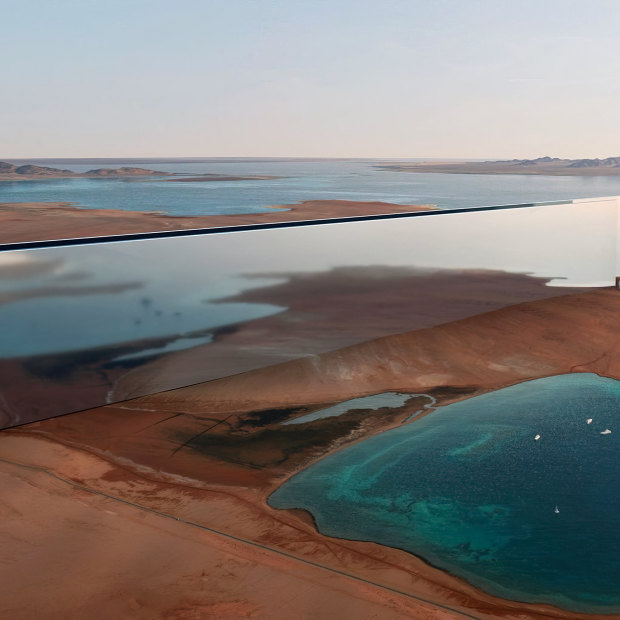
The line, a city planned to house up to 9 million people (artist’s view), is envisaged to stretch 170 kilometres from the Red Sea.Credit: AAP
Welcome to the “land of the future”, where the buildings look like they have been designed by artificial intelligence on acid: the product of algorithms uncoupled from the mundane constraints of practicality, price and place. A state-of-the-art yachting town being constructed on the Gulf of Aqaba could easily have been modelled on the mythical realm of Wakanda from the Marvel blockbuster, Black Panther. A render of a ski resort with the dreamy name of Trojena looks from the air like a giant white squid reclining, insouciantly, on a bed of jagged mountains. A subterranean community called Aquellum will feature an “ultra-luxury upside-down skyscraper” configured around an underwater open square. “It’s an experiential space that will change you forever,” promises one of its architects, Nathalie Rozencwajg, in a promotional video that looks like a trailer for a science fiction movie. “It’s a metaverse that you can physically experience.”
All of these fantastical schemes are part of Saudi Arabia’s Vision 2030, the pet mega-project of its de facto leader, Mohammed Bin Salman, or MBS as the 38-year-old Crown Prince is popularly known. The aim is to make Saudi Arabia a global hub for business, to rethink urbanism and to become what’s termed “an accelerator of planetary regeneration”. It is a kingdom of the human mind where utopianism and authoritarianism intersect.
The centrepiece of these so-called giga-projects is NEOM – a portmanteau which marries the Greek prefix neo meaning “new” with the “m” from the Arabic word mostaqbal, which means future. Presently the world’s largest construction project, it will eventually transform 26,500 square kilometres in the remote north-west region of the country, where Saudi Arabia meets Egypt and Jordan, into a metropolis roughly the size of Belgium and 33 times bigger than New York City. The signature development, the elongated jewel in MBS’s crown, will be The Line, which is designed to stretch through the desert for 170 kilometres with parallel 500-metre skyscrapers extending along its length. To convey a sense of the mind-bending scale, One World Trade Centre in New York is a little over 500 metres tall, and, at its base, roughly 60 metres wide. So try, if you can, to imagine more than 2800 One World Trade Centres butted side to side, with another 2800 or so facing directly opposite. A “new Babylon” is how the scheme has been described, though it will be notable more for its acres of mirrored glass than its verdant hanging gardens. Apparently, the Crown Prince is a huge fan of mirrored glass.
Intended as the home for some 9 million people, future residents have been promised a car-less habitat with “all daily essentials” always within a five-minute walk. “It can’t be understood until it’s built,” said the Pritzker-winning American architect Thom Mayne, who has worked on the masterplan, a statement at once bold and baffling.
To describe these schemes as a “Mecca” for the world’s leading architects feels, given their location, especially apt. Bjarke Ingels, the ubiquitous Danish “starchitect”, is designing the Oxagon, a reimagined industrial port city touted as “the world’s largest floating structure”. Dominating the Trojena ski resort will be a 330-metre skyscraper by Zaha Hadid Architects (although its charismatic female founder died in 2016). The Pritzker-winning French architect Jean Nouvel is behind Siranna, a luxury hotel sculpted into a sandstone hill in the Al-Ula desert, which looks like a modernist take on the ancient city of Petra. Saudi Arabia has assembled an all-star architectural A-list, but in its bid to build the ultimate city of the future, it has also recruited creative directors from Hollywood. Their credits include Marvel movies, such as Guardians of the Galaxy, with their sci-fi flights of fancy, and even Harry Potter.
A lot of Australians are also involved. The architectural firm Woods Bagot is designing the Siranna complex, comprised of hexagonal pillars intended to blend into the adjoining mountain. The multi-disciplinary design firm, McGregor Coxall, which worked on the landscaping of the Sydney Modern art gallery, has been signed up. LAVA (Laboratory for Visionary Architecture), which has an office in Sydney, is overseeing the Trojena masterplan.
The Saudis have also attracted some of Australia’s leading cultural brokers to promote the kingdom’s newfound emphasis on film, the arts and live music. The movie director Baz Luhrmann chaired a jury at last year’s Red Sea International Film Festival held in Jeddah. Luhrmann toured the country beforehand to carry out what he described to Screen Daily as his “own investigation about a lot of the big changes that are taking place”. He commended his hosts for the “enthusiasm, commitment and fiscal muscle that they’re putting into the film-making environment”, which was especially noteworthy in a country where cinemas only reopened in 2018, after being banned for more than 30 years.
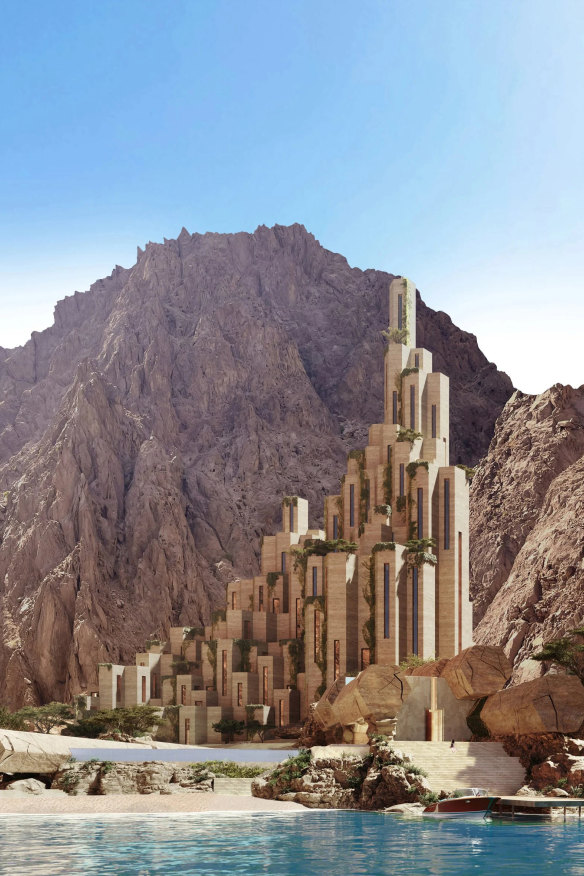
Australian architectural firm Woods Bagot is designing this hotel complex, Siranna, which incorporates hexagonal pillars.Credit: NEOM
The arts administrator Michael Lynch, the former CEO of the Sydney Opera House, London’s Southbank Centre and the West Kowloon Cultural District Authority in Hong Kong, joined towards the end of last year. Then there are the Aussies working behind the scenes. The former deputy premier of NSW, Andrew Stoner, has served on an advisory board. Up until August 2022, the former chief executive of Tourism Australia, Andrew McEvoy, headed up NEOM’s tourism sector. The one-time Liberal National Party MP, Wyatt Roy, who, aged 25, became the youngest minister in Commonwealth history during Malcolm Turnbull’s prime ministership, has recently joined the leadership team.
Of the more than 80 nationalities thought to be taking part in the project, only Saudi Arabia itself and Britain have a greater number of people working on the project than Australia. Some have been described as “coin-up players” motivated by the remuneration packages on offer. Others have been lured by the chance to work on a once-in-a-lifetime scheme where the creative opportunities are so limitless. Maybe, in the parched desert, some have over-indulged on Kool-Aid or succumbed to the hallucinatory effects of the heat, but many seem genuine and completely clear-minded: they want to build a modern-day wonder of the world.
“At 72, life is something you’ve got to grab by the horns rather than let those horns pierce you through the heart.” It is Founding Day, which commemorates the establishment of the first Saudi state in the early 18th century, and Michael Lynch is kicking back. Home for the past three months has been a compact, prefabricated apartment in the NEOM construction village known as The Camp, which he describes as a cross between The Truman Show and Los Alamos, where J. Robert Oppenheimer’s Manhattan Project developed the first atomic bomb. Lynch reckons he is “the oldest guy in the village” and something of a “mad old man”. He’s now head of NEOM’s entertainment and culture sector. Before he took the job, his friends back home warned that he might “die in the desert”.
His learning curve has been as vertiginous as the giga-project’s towering schemes. Previous visits to the Gulf states merely involved “getting on and off planes” as he flew between Sydney and Europe. About Saudi Arabia, he was “woefully underinformed and ill-informed”. When we hook up via FaceTime, he tells me: “I was naively expecting this to be a medieval society. My personal understanding of Saudi Arabia was six to eight years out of date.”
Now at the end of his three-month probationary period, he’s clearly enamoured of the project, where he is overseeing the cultural assets planned for The Line – a concert hall, arena, theatre and museum. “It’s bigger than big,” he laughs, “and what sort of project could bring Michael Lynch and Wyatt Roy together as lunch buddies in the desert?”
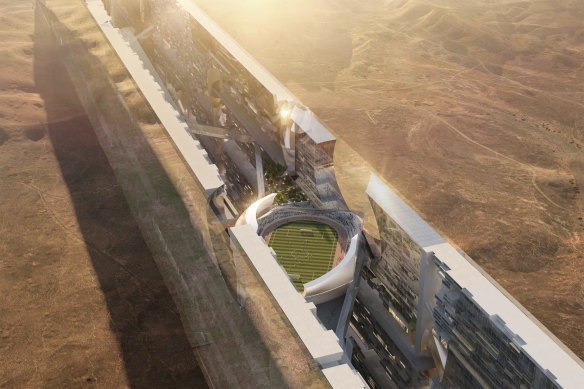
An aerial projection of The Line: no cars will be allowed inside.Credit: NEOM
But what about his Saudi paymasters, I ask, and a human rights record as poor as the petrostate is rich? “I had a lot of questions,” he admits, “but I also did a lot of due diligence.” Like many Westerners working for the Saudis, he appears to have rationalised his involvement by thinking of himself as an agent of change. “Saudi Arabia has changed fundamentally in the past six years,” he claims, pointing to the number of Saudi women involved in the project. “The story has been one-dimensional. The women story is infinitely more complicated. The Saudi women working for me have been educated in the finest universities in the world. The one thing I took more stick on was on the role of women. But one thing the Crown Prince instigated years ago was for women to play a formidable role.
“The story of the women is a symbol of how things are changing. There are big things happening. It is one of the major areas of change. That’s going to be a good thing, and contribute to a much more open place.” Still, of the 20 executive positions listed on the NEOM website, only two are occupied by women.
For Lynch, the chance to work in Saudi came at an opportune moment. In 2021, he lost his beloved wife and soulmate, Chrissy Sharp, an acclaimed arts administrator who had run the Sydney Writers’ Festival and the Sadler’s Wells Theatre in London. Job openings for septuagenarians categorised as, he says, “pale, male and stale” were also drying up. The NEOM project therefore became “almost irresistible”.
“It’s changing my world view … watching a place change incredibly fast. It’s been mind-blowing.”
Michael Lynch
It’s not a decision he has so far come to regret. “Looking at the hole in the land where The Line joins the sea, I could barely believe the scope and the scale. That’s the galvanising thing that has brought people to this project. I probably feel more energised now than for a long time.” His health has also improved because of the Saudi prohibition on alcohol. “This place is fuelled by sobriety,” he grins.
So far, it’s been an educational experience. “It’s changing my world view,” he says. “You’re watching a place change incredibly fast. It’s been mind-blowing to watch the speed of change. You make the comparison with what’s going on in Iran. This place is trying, within the confines of a Muslim society, to do things in a different way.”
The Parthenon in Athens. The Pantheon in Rome. The Great Pyramid of Giza. Nothing makes a bolder civilisational statement than monuments and buildings, for the simple reason they can remain standing for thousands of years and thus become so enduringly epochal. Down the centuries, emperors, pharoahs and dictators have seen grand architectural projects as a useful propaganda tool: emblems of personal strength and durability. Classical idioms are often favoured because they bestow upon regimes a sense of historical legitimacy and create the illusion of national revival and contemporary greatness.
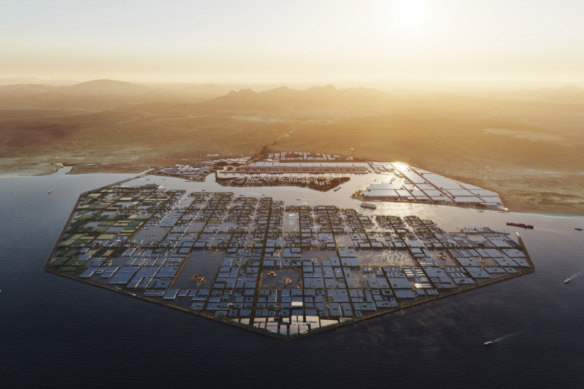
The Oxagon: the proposed port city would be the world’s largest “floating structure”.Credit: NEOM
Hitler, aided by his chief architect Albert Speer, had ambitions to build Germania on the site of Berlin, a city dominated by a giant Volkshalle (people’s hall) with a dome more than a dozen times larger than St Peter’s Basilica in Vatican City. Mussolini bulldozed a swathe of ancient ruins to create a giant parade route with a direct line of sight from his balcony at the Palazzo Venezia to the Colosseum. During his term in the White House, Donald Trump issued a presidential directive that all new federal buildings should be built in the classical style, the authoritarian aesthetic.
Mohammed Bin Salman is trying to pull off a different trick. The giga-projects are not so much about triumphalism as transformation. Futurism rather than nostalgia. Saudi Arabia claims it wants to pivot away from oil, the fountainhead of its vast wealth, and to diversify the economy in an ostentatiously more environmentally friendly manner. “We want to create the new civilisation for tomorrow,” MBS cheerfully told the Discovery Channel last year, in a rare on-camera interview in which his amiable side was on show, and made him seem more like a Fresh Prince of Bel Air.
There is also a demographic imperative. More than 60 per cent of Saudis are under the age of 30, and the country needs to create employment opportunities in new fields. In what has long been a hermit kingdom, where foreign visitors have mainly been pilgrims drawn to its holy shrines, tourism is a prime area of growth. Here the aim is not just to attract international travellers but also to capture Saudi money spent for decades in the hotels and boutiques of London, Paris and Dubai.
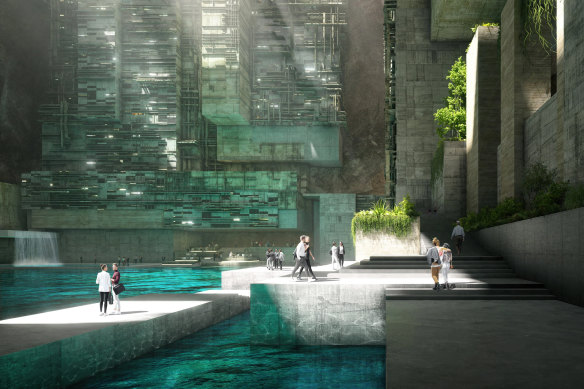
Aquellum: artist’s view of an “upside-down skyscraper” – inside a mountain.Credit: NEOM
As well as revamping the international image of the petrostate, the giga-projects are also intended to rehabilitate the reputation of its de facto ruler. When he first came to power in 2017, aged just 31, MBS presented himself as a Western-friendly moderniser and signalled his reformist intentions by pushing for a royal decree lifting the ban on women driving cars. To further impress the West, he also distanced the House of Saud from Wahhabism, the austere form of Sunni Islam propagated by Saudi Arabia, which has been identified by security experts as a source of Islamist terrorism. Fifteen of the 19 terrorists who hijacked planes during the attacks of September 11 were Saudi citizens.
“Mr Everything”, as King Salman’s favourite son and top adviser is nicknamed, also proved himself a consummate networker. At a dinner in Washington, D.C. hosted by the then US secretary of state John Kerry, he spotted a grand piano and decided to serenade those present with an impromptu rendition of Beethoven’s Moonlight Sonata. When Donald Trump became president, he forged a warm relationship with a tycoon who has long had a soft spot for authoritarians, and became a text buddy of Trump’s son-in-law, Jared Kushner. Not long after Kushner left the White House, his private equity fund received a reported $2 billion investment from a sovereign wealth fund controlled by MBS.
This avid gaming fan, who tends to sleep late in the morning to be in sync with American time zones, also courted the princes of Silicon Valley, such as Facebook founder Mark Zuckerberg. More unexpected has been his bromance with the movie star, Johnny Depp, whom MBS let use his personal 747 jumbo jet, and entertained aboard his 130-metre super yacht, Serene, the flagship of his personal armada (and also the floating home for a time of the Leonardo Da Vinci painting, Salvator Mundi, which MBS acquired in 2017 for the world record-setting price of $US450 million). The two apparently chat long into the night, especially about MBS’s plans to revive the Saudi movie industry.
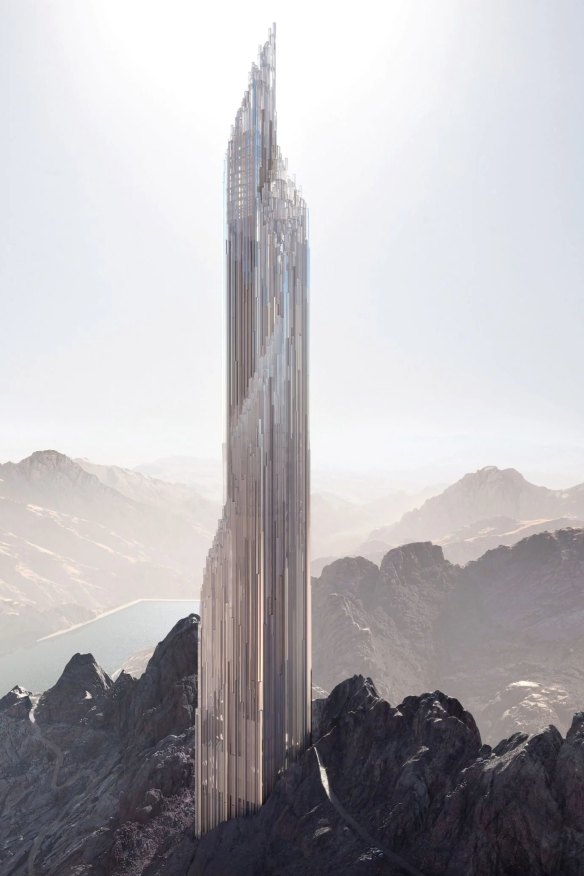
Trojena: Zaha Hadid Architects’ vision for a 330-metre skyscraper at the planned ski resort.Credit: NEOM
Yet this Western charm offensive went hand in glove with an iron-fisted crackdown at home, during which MBS revealed himself to be the most ruthless of Renaissance men. In 2017, his security services rounded up more than 300 of the richest and most powerful men in Saudi Arabia, including some of his own relatives, and held them at the Ritz-Carlton in Riyadh under the guise of an anti-corruption purge. In this five-star form of house arrest, detainees were allowed to watch television and run up bills on room service, which gave his power play an almost comical feel, but afterwards, some revealed they had been beaten and tortured. Only two weeks before, the Ritz-Carlton had hosted a launch event for NEOM.
Worse was to come with the murder of Jamal Khashoggi, a dissident Saudi journalist whose columns in the Washington Post lambasted the Riyadh regime. Within minutes of walking into the Saudi consulate in Istanbul on October 2, 2018, Khashoggi was ambushed, tortured, beheaded and dismembered with a bone-saw by a 15-man Saudi assassination team. The CIA believes that MBS approved the hit (an accusation he has denied, while at the same time taking “responsibility” for the actions of Saudi government officials).
NEOM came to be seen in a more shadowy light: not as the landmark of a moderniser but rather the trophy project of an inveterate despot – the M in NEOM, after all, is also seen as a homage to MBS. In the aftermath of the Khashoggi murder, Norman Foster, one of the world’s leading architects, stepped down from NEOM’s advisory board. The Washington Post blasted MBS’s new mega-city for being “built on a foundation of tyranny”. Utopianism meets authoritarianism meets dystopianism.
“Once a building is built, you never get that carbon back. The Line is just insane in this regard.”
Professor Daniel Barber, head of school, architecture at Sydney’s UTS
In the years since Khashoggi’s murder, Saudi Arabia’s image overhaul has gone into overdrive. It has staged concerts by Mariah Carey and Justin Bieber and, in 2021, hosted its first Formula One grand prix. This month, the Saudis formally announced their bid to host the 2034 FIFA World Cup, which is seen as a formality since it is the only country to enter the bidding contest.
On the Western diplomatic circuit, MBS has been granted re-entry into the inner sanctum. US President Joe Biden, after labelling Saudi Arabia a “pariah” during the 2020 presidential campaign, fist-bumped MBS when the Crown Prince welcomed him to Jeddah in July, 2022, a bro-ey absolution. In June last year, the French president Emmanuel Macron welcomed the Crown Prince for a one-on-one lunch at the Élysée Palace.
However, the kingdom’s human rights record is still appalling. “Saudi Arabia’s absolute monarchy restricts almost all political rights and civil liberties,” the democracy watchdog Freedom House noted in its 2023 report. “The regime relies on pervasive surveillance, the criminalisation of dissent, appeals to sectarianism and ethnicity, and public spending supported by oil revenues to maintain power. Women and members of religious minority groups face extensive discrimination in law and in practice. Working conditions for the large expatriate labour force are often exploitative.” Indeed, over the period of MBS’s rule, the Saudis’ human rights score from Freedom House has regressed. In 2017, it was 10 out of 100, whereas in 2023, it hit eight.
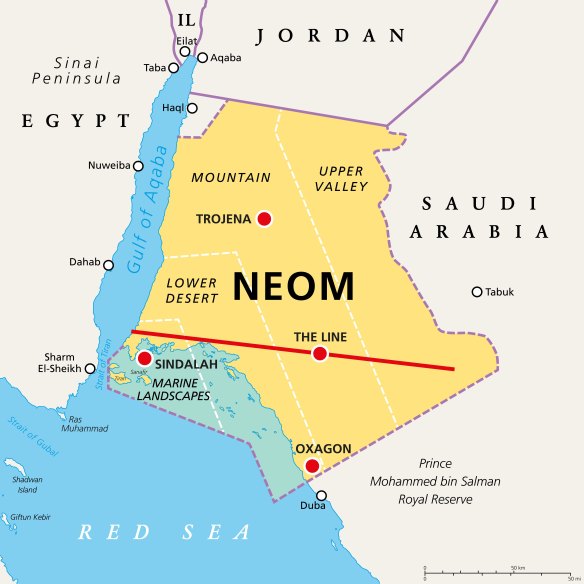
NEOM is sited in the north-west of the country, bordering Jordan and Egypt. The world’s largest construction project, it covers the equivalent area of about 33 New York cities.Credit: Alamy
The United Nations and human rights groups have also singled out the NEOM project for criticism, citing the forcible eviction of members of the Huwaitat tribe which, for generations, has populated that region. In 2020, Saudi special forces shot to death Abdul Rahim Al-Huwaiti, a tribal activist who voiced criticisms online, after he refused to give up his property. (The Saudis claimed the forces were acting in self-defence after coming under fire, although human rights activists say he briefly returned fire only after his home came under assault.) In 2023, UN human rights experts condemned the death sentences reportedly handed down to three Huwaitat tribe members resisting forced evictions linked to the NEOM project, who were charged under vague anti-terrorism laws. Concerns have also been raised over plans to use artificial intelligence in The Line, which could make it easier to conduct mass surveillance on residents. “Authorities launder their reputation,” Human Rights Watch concluded in its 2023 World Report, “stained by a deplorable human rights record, through funding lavish sports and entertainment institutions, figures, and events.”
The project’s environmental credentials are also murky, and have brought allegations of greenwashing. Central to the oil kingdom’s extreme makeover is the boast that NEOM will set the gold standard in sustainability and environmentalism. “It will run on 100 per cent renewable energy and 95 per cent of land will be preserved for nature,” claims NEOM’s website. But climate groups have highlighted the problem of embodied carbon, the environmental costs associated with constructing the buildings, and operating them over the course of their life spans.
“To build a structure of this scale, with these kind of structural gymnastics, would require an astronomical amount of materials,” says Philip Oldfield, a professor of architecture at the University of NSW. It’s a complaint echoed by Professor Daniel Barber, who heads the school of architecture at Sydney’s UTS. “Once a building is built, you never get that carbon back. The Line is just insane in this regard.“
Over dinner in Sydney recently, Professor Barber listened to an Australian involved in one of the projects wax lyrical about the joys of working with so few normal constraints. “I said, ‘Come and talk to my 18- and 19-year-old students, and let them listen to a mature architect talk so dismissively about the environmental externalities forced on our children.’ It’s appalling, frankly. With something as excessive and egregious as The Line, even if it ends up being powered by solar panels, so much carbon is spent on constructing those buildings that you’ve already lost the game.”
Even academic reports from within Saudi Arabia have expressed misgivings about the environmental impact. “While diversifying the economy, giga-projects will increase the number of people living [in] or visiting coastal areas, placing an additional burden via waste generation and disposal, water desalination and energy consumption, as well as add pressure to the overuse of local resources,” noted a report from King Abdullah University of Science and Technology. “For Saudi Arabia, this isn’t just business as usual,” says Daniel Barber. “It’s dialled up. It’s not re-arranging the deckchairs on the Titanic. It’s dancing on the deck as the ship goes down.”
Bad urbanism is another complaint from those who question the desirability of a vertical city. If, as planned, The Line becomes the home to 9 million people, some 260,000 people will be crowded into every square kilometre on average, according to Philip Oldfield’s calculations. The City of Sydney, by contrast, harbours 8000 people per square kilometre; the City of Melbourne, 4300. The highest urban density has long been found in the Mongkok district of Hong Kong, at 130,000 per kilometre – less than half of what is planned for The Line. Put another way, 9 million people will occupy just 34 square kilometres of land. London, which has roughly the same population, is sprawled over 1500 square kilometres. “There is just no kind of precedent for this kind of development,” says Oldfield.
NEOM claims there are virtues of a vertical city, and that its small footprint is designed to leave surrounding ecosystems untouched. The idea is to let nature sprawl into the city rather than the city sprawl into nature. “We think there’s an opportunity to create a better model for a city to interact with the landscape and the environment,” its Australian chief development officer, Denis Hickey, said in a video released by NEOM last month, “and we think The Line is going to be an example to the rest of the world.”
However, the scale, cost and feasibility of the giga-projects have raised questions as to whether MBS’s vision will ever be fully realised. Though they are being funded by the Kingdom of Saudi Arabia’s sovereign wealth fund, which is estimated to have assets of $US776 billion ($1.2 trillion), NEOM cannot draw on a bottomless pit of petro-dollars. Given the gargantuan development costs, sceptical urban planners reckon that it will be hard to finance more than 10 kilometres of The Line.
Cities, moreover, usually take generations to build, which is at odds with NEOM’s concertina-ed timeframe. “Creating a city this quickly, and at this scale, has never been done before,” says Philip Oldfield. For example, Brasilia, which in 1960 was inaugurated as Brazil’s capital, has taken more than 60 years to reach a population of almost 5 million.
Yet NEOM claims that the first phase of The Line will be completed by 2030, and the Saudis point to the transformation of its capital Riyadh, with its super-tall skyscrapers and new expressways, tunnels and bridges. Those involved in the project are also determined to prove wrong the critics. In a recent post on LinkedIn headlined “Neom is real”, Giles Pendleton, the South African-Australian chief operating officer of The Line, published a gallery of aerial pictures which showed a mammoth channel being carved through the desert. “How to answer the naysayers about the incredible work being done in NEOM?” he asked, pointedly. “Show a cross-section of the world’s largest building site from the mountains to the sea.”
The Crown Prince, as one would expect, is bullish. “They say a lot of projects in Saudi Arabia can’t be done, they’re too ambitious,” he told The Discovery Channel. “They can keep saying that, and we can keep proving them wrong.” A view within NEOM is that the projects are not as mad as they look, and that if you begin with the proposition that you are working on a blank canvas, the designs no longer feel so wacky and eccentric.
An irony of the NEOM project is that those involved speak of a radicalism of thought and vision rarely found these days in the West. Certainly, many of the world’s most futuristic buildings are being built in countries such as China and the United Arab Emirates, where design freedom is not matched by political liberties. As the architecture critic Deyan Sudjic observed back in 2005, in a book entitled The Edifice Complex, totalitarians have been offering architects “more opportunities for ‘important’ work than the liberal democracies”.
Worryingly for the architectural profession that’s even more true now, and it is what makes the Saudi giga-projects so morally fraught. In non-democratic countries, with deplorable human rights records, how can the architecture of the future also be an architecture of ethics – and where do you draw a line?
To read more from Good Weekend magazine, visit our page at The Sydney Morning Herald, The Age and Brisbane Times.